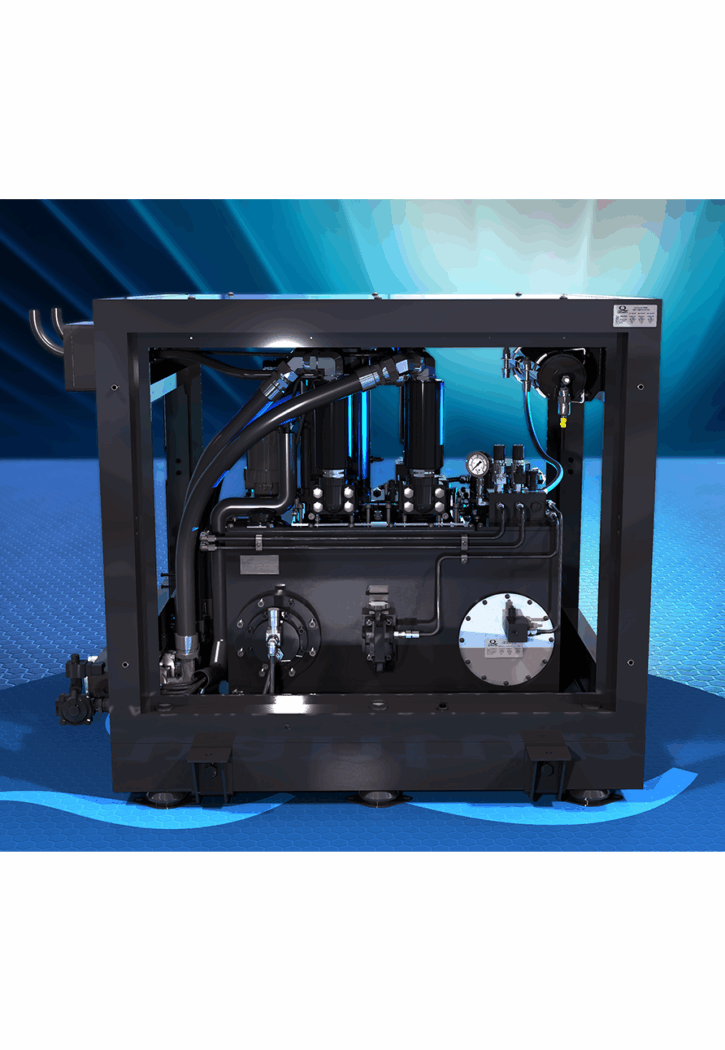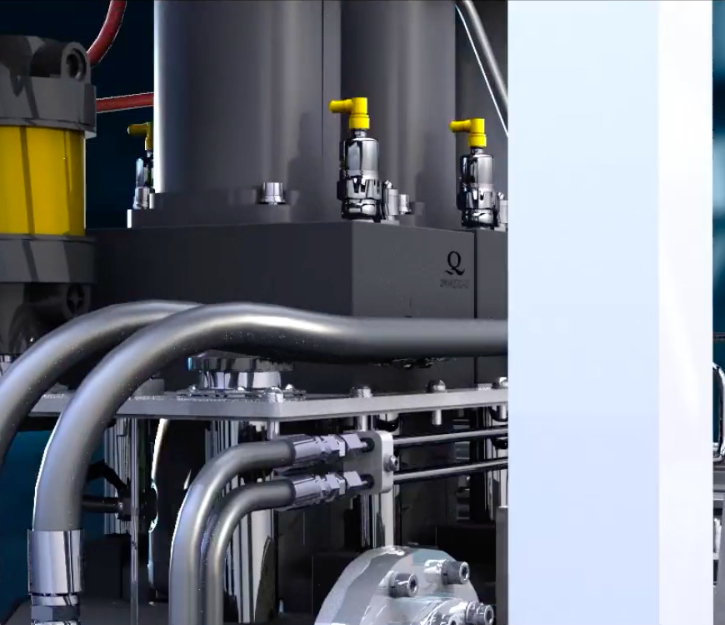General
Inquiry Form
F45 Electric - Hydraulic Hybrid Power System
A Game Changer in Yacht Stabilization
The world’s first scalable hydroelectric hybrid power system
In support of the eco-friendly movement and a more sustainable future for the yachting industry, Quantum is introducing a revolutionary breakthrough in powering stabilizers. The new patent pending, F45 – Integrated Hybrid Power System, uses the best attributes of both hydraulic and electric power sources.
The first system was installed in March 2024, 47m Feadship, with several other units to follow in the coming year. After over four years in development and six months of intense testing, the F45 is designed to dramatically reduce stabilizer power consumption, without the use of potentially dangerous batteries.
“When you consider a yacht at anchor, the two largest power-consuming sources are air conditioning and stabilizers, and we are now taking 60% of the power out of the stabilizer system. This really makes the F45 a game changer. It’s a changer for everything!”
John Allen, Quantum CEO

What is the F45 Hybrid?
The F45 is a innovative, electric-hydraulic hybrid power system that is scalable to larger vessels. This Hybrid Power System offers an alternative method to powering stabilizers, using the best features of a traditional hydraulic system and the cleaner advantages of a direct electric drive, making it major break-through in stabilizer technology! Overall, it requires 60% less power than a standard hydraulic system, only consuming energy as required, when required.
A traditional hydraulic system will continue to draw 40% of the maximum power, even when it is not needed, so there is a lot of wasted energy. The F45 drops to less than 1kW when in standby mode. These efficiencies do result in extreme power fluctuations that can cause problems for the ship’s generators and the overall grid. The remedy? Quantum has developed a solution to store and recover energy through the proprietary M.E.S.S. (Mass Energy Storage System).
Electric fin stabilizers also have some drawbacks, especially in larger vessels (60m+). They become cost prohibitive due to the prices associated with gear boxes and servo motors. Electric fins with gear boxes must be designed to withstand slamming loads, which is easier for hydraulic systems to handle with relief valves.
The F45 hybrid is a feat in engineering with it’s simplified, closed loop design to sweep the fins, proven to be 4X quieter that a traditional hydraulic system and does not generate heat. All of these attributes while reducing the carbon footprint and operating costs.
Although Quantum is no stranger to innovative marine stabilization systems, they now have four international patents for the XT™ Fin, MAGLift™ Rotor and Dyna-Foil™ systems as well as introducing Zero Speed™ stabilization in 2000.

How does the F45 Hybrid Power System reduce power consumption?
The F45 has the capability to manage the power fluctuations, as well as store and recover power through a proprietary solution, called M.E.S.S. (Mass Energy Storage System). This flywheel technology has the ability to outstrip a traditional capacitor bank by a power density of 8 times. Furthermore, any excess energy from fin deceleration (zero speed) or hydrodynamic force (underway) can be recovered and stored for future use through Dynamic Energy Recovery.
The F45 uses a high dynamic servo motor, coupled to a low inertia hydraulic pump, that greatly simplifies the overall system and removes all of the components that make hydraulics inefficient.
The F45 hybrid:
- Generates smooth power that does not fluctuate and limits cyclical loading.
- Boasts 60% greater efficiencies, partially due to the elimination of control valves in exchange for a servo motor.
- Buffers the energy to mitigate the extreme fluctuations to stay within 15% – 20% of the dynamic range of the average power consumption.
- Recovers 80% of the energy while the fin is traveling back towards the neutral position.
- The efficiencies with this electric/hydraulic hybrid power system are unprecedented, being touted as “redefining the stabilizer industry.”

Features of the F45
Up to 80% Power Reduction
Four Times Quieter
Energy Storage
Energy Recovery
F45 Hybrid Interview
Discover the F45 and its advantages in this video with Quantum CEO John Allen.
Key Advantages of the F45 Hybrid System
The F45 is not only a groundbreaking technology for all Quantum”s new equipment but can also be extensively retrofitted to almost everything they’ve designed in the past, with the auspice that the unit can reduce the power required on board. The F45 power pack offers smooth power that does not fluctuate and requires 60-80% less power than a traditional hydraulic system. Meanwhile, it boasts greater efficiencies, only consuming the energy as required, when required. Benefits stemming from this are:
- Low airborne and structure-born noise levels
- Minimal heat generation
- Simplified maintenance requirements
- Smaller carbon footprint
- Increased reliability and dynamic control
- Sound and vibration isolation
Limitations of traditional hydraulic systems
A traditional hydraulic system will continue to draw 40% of the maximum power, even when unnecessary, resulting in wasted energy and air pollution. The F45 Hybrid drops to less than 1kW when in standby mode.
Hydraulic systems also generate significant noise and heat levels during operation and can be complex to install and maintain. While the F45 can integrate smooth, safe, and precise operation usually associated with hydraulic systems, it can reduce the airborne noise and heat generated.
Limitations of traditional electric systems
Electric fin stabilizers on larger vessels (60m+) become cost-prohibitive due to the prices associated with gearboxes and servo motors. Electric fins with gearboxes must be designed to handle slamming loads, which is easier for the F45, which relies on the relief valves of a hydraulic system.
Most electric systems rely on batteries or power generation methods that could have environmental impacts. With the F45’s unique ability to store and recover energy, a safer, more sustainable form of yacht stabilization is possible.

Frequently Asked Questions about the F45 Hybrid
When will the F45 Integrated Power System be available?
The F45 will be available in June 2023, and ready to be used by both yachts and military vessels. The F45 Hybrid is completely scalable to large and small vessels and can be retrofitted to most of Quantum’s previous designs. Not only is this one of the best innovative technologies of the past years, but it is also one of the most significant sustainable solutions to increase energy efficiency on board.
To what extent do renewable energy technologies reduce carbon emissions on a yacht?
The extent of the energy reduction depends on the size of the yacht, as well as the vessel’s cruising patterns. An integrated power system like the F45 Hybrid can recover and store energy when a ship’s fins are being hydrodynamically moved, resulting in up to 80% reduction of power usage on board.
Does utilizing renewable energy sources mean less cost?
After the initial installation, innovative systems like the F45 require minimal ongoing maintenance, reducing long-term operational expenses. Our engineers have calculated that For 10.000 hours of usage on a 110m vessel, the savings associated with the installation of an F45 will be around 800,000 USD in gas.
What are other sustainable trends in the yachting industry?
Builders and engineers are embracing sustainable practices to minimize their environmental footprint and ensure the marine industry is working towards a more sustainable future. This includes implementing water-saving technologies like onboard water recycling systems, low-flow fixtures, and energy management systems to optimize energy usage. Waste management solutions and recycling programs are also becoming common in the yachting industry, contributing to environmental conservation efforts.
Furthermore, yachts are increasingly constructed with sustainable materials such as responsibly sourced wood and eco-friendly composites. Energy-efficient designs, including hulls that reduce drag and lightweight materials, are prioritized to enhance performance while reducing fuel consumption and greenhouse gas emissions. Additionally, adopting electric propulsion systems powered by batteries or fuel cells is gaining traction, offering zero-emission operation and mitigating environmental impact.